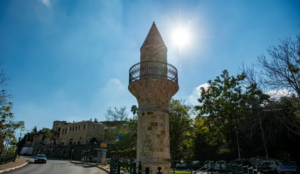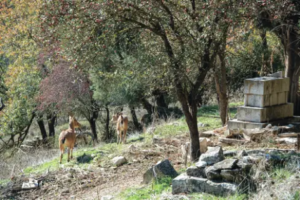Safed’s non-Jewish treasures face disrespect and vandalism

The spire of a Safed mosque, 17 November 2020
Noa Shpigel reports in Haaretz on 27 November 2020:
Visitors to one of Safed’s ancient structures are greeted by a rundown facade. Above what has become a parking space, tacky plastic shutters were built into the impressive brick wall. Graffiti was sprayed on a few stones. Air conditioners are attached to the ancient wall with big ugly screws.
A glance up at the roof will find wild shrubbery and a modest rock dome, hinting at the building’s past.
It was built in 1372 by the Mamluk governor of Safed, who decided to erect a mausoleum here. It served as the burial site of the city’s rulers, such as Emir Mozaffar ad-Din Musa ibn Hajj al-Ruqtay, the city’s naib (governor) who died the year it was inaugurated. Later, in the Ottoman period, the structure was used as a zawiya, a Sufi prayer site.
A tour of the building, almost 650 years old, doesn’t reveal much about its past. The sign at the entrance indicates that it is now the municipal social affairs department. A woman there admits she knows nothing of the site’s historical roots. She didn’t know it had been a Mamluk zawiya named after the Hamed daughters. A long time has passed since it had been one of the city’s central buildings. The graves in its yard were flattened many years ago and its purpose has been altered more than once.
An attempt to trace its near history will disclose that it was used as a Freemasons’ meeting place and in later years as a storeroom of the Antiquities Authority. Impressive ancient inscriptions carved in stone had testified to its past. One such engraving had been inlaid in the building’s grand facade. But after another building and a road had been constructed there, the building’s facade became its side. Beneath the inscription lies a neglected yard with tall weeds and sumac trees, as well as the remnants of blankets and books – signs that a homeless person lived there until recently.
This inscription was one of a few that survived, while others were destroyed or vandalized. Only two months ago, Professor Mustafa Abbasi, a historian at the Academic and Technology College of Tel Hai, says he had photographed it. But at the beginning of the month he discovered it was gone. Torn out of the ancient wall.
The zawiya was only one of numerous ancient non-Jewish sites in Safed. A tour of these sites last week showed that in many cases their history was not preserved. Buildings were constructed on some Muslim and Christian graveyards. Other graveyards’ tombstones were destroyed and the remaining structures neglected. Arabic engravings that had decorated them were damaged or simply don’t exist anymore.
“The state should take care of this place,” says Yosef Stefansky, a Safed archaeologist formerly with the Antiquities Authority. “These are the most ancient structures in the whole Galilee that are still standing,” he says.
Yosef Stefansky, a Safed archaeologist formerly with the Antiquities Authority, and Professor Mustafa Abbasi, a historian at the Academic and Technology College of Tel Hai, Safed, November 17, 2020Credit: Gil Eliahu
He doesn’t think the site was effaced because it isn’t Jewish, but because the engravings had been torn out “since they annoyed someone, or because they can be sold.”
Spreading destruction
The first round of vandalization took place soon after the War of Independence, when Safed had been conquered from the Arabs. The Arabs were the majority there during the British Mandate era and had harassed the Jewish minority.
After the fighting, the temporary Israeli government ordered the restoration and closure of some of the sites to the public to prevent further damage. But now, more than 70 years later, their condition is grim.
“A few structures of special historic significance remain in Safed, important not only to the city but to the country’s history in general,” says Abbasi. The damage to Muslim and Christian historic and archaeological sites has become widespread, he says.
Apart from the mausoleum, there are “mosques that have been partially or totally destroyed.”
One such place is the Red Mosque, erected by the Mamluk sultan Baybars in 1276, located a few meters from the zawiya.
A gate placed at the entrance prevents access to the yard. Through it one can see the muqarnas (decorative structure) that has been preserved outside the building. The building itself is another story. It’s no longer a mosque and Abbasi said its purpose has been changed. In the 50s it was converted into a yeshiva, then a clubhouse and now it is earmarked to be a banquet hall, he says.
Outside the building an iron signpost frame bears the inscription “story of the site.” Frames of this kind can be found near various sites in the city but frequently, like here, they are empty. The site has been altered and its story erased. Abbasi believes the signposts are blank because of the Mamluk story they had told.
Stefansky remembers that when those signposts still carried a plaque with a story, “people used to erase them. Make graffiti on them. Not Safed residents necessarily, extremists from outside.”
A similar blank signpost stands outside Jacob’s Cave – or Shem and Ever Cave, depending on whom you ask – in the city center. The cave is a remnant of the Byzantine era. According to Muslim tradition, Jacob sat here mourning over Joseph’s disappearance. Abbasi says that a hair of the Prophet Mohammed’s beard had been kept in the mosque on this site. According to later Jewish tradition, the cave marked a seminary built by Shem and Ever, Noah’s son and grandson. Over time the cave became a symbol of coexistence, Abbasi says. In drought years Arabs and Jews used to pray there together for rain.
“This site was a meeting place of cultures, a place of partnership,” he says. “It wasn’t anti, it was together.”
But things have changed since then. In the ‘50s, says Stefansky, the ancient engraving describing Muslim tradition was taken from the wall there. He says a Jewish man boasted to him that he had been among those who took it out. “Our goal is to return the inscription and preserve what has survived,” he says.
Not far from there lies the city’s marketplace. Once it was Aljora neighborhood and in the Ottoman era it surrounded a mosque. Today only the minaret still rises over the road built near it. But even the minaret hasn’t survived in one piece: About seven years ago the crescent was plucked from its tip.
Pieces of tombstones in the park
The pastoral Emek Hatchelet Park on the city’s north side is a mix of peacefulness and destruction. The park itself is popular among hikers, especially since the coronavirus outbreak. It has ponds, fruit-laden hawthorn, olive trees and wildlife. A young fawn was sighted last week on the mountainside, beside a broken tombstone. The fawn strolled on the site of a Christian-Muslim graveyard from the British Mandate era.

Blue Valley Park in Safed, 17 November 17 2020
Today not a single tombstone seems to have been left whole. Abbasi says the relatively new damage has been done in recent years. The pain is also fresh – some of the relatives of the deceased still live around the city. “When a Jewish cemetery is desecrated anywhere in the world, a hue and cry is raised. I expect the municipality to protect graveyards here as well,” says Abbasi.
This is not an isolated incident, other graveyards have disappeared completely, he says. One is the ancient Kurdish neighborhood graveyard, named after the saint Abu Kamis, who was buried there. Two years ago construction on the site was completed and Gan Habanim – a memorial site for fallen Jewish soldiers – was inaugurated.
The second such graveyard is the Makberet al-Catef cemetery in the south of the city, which disappeared in the ‘50s.
Another graveyard in the process of extinction is located beside the Seraya, the Ottoman governor’s house, in the city center. Intensive construction work is taking place inside a large fenced area. A signpost tells people that a courthouse will soon be built here.
But the new building isn’t being erected on a vacant plot. In the past an ancient graveyard was located here. Over the years an auditorium named after Yigal Allon was built on half of it.
“The Antiquities Authority carried out excavations but they found only Ottoman graves,” says Stefansky. “Under Yigal Allon House there were Mamluks as well.” After the authority finished documenting the findings, the area was returned to the developer.
“For hundreds of years Safed was a city of coexistence,” says Abbasi. “Great rabbis lived there beside Sufi leaders. Now the heritage of culture representing Safed’s Arab and Muslim past is continuously being destroyed. It’s unthinkable, for example, to destroy the sacred Ari Synagogue,” he says by way of contrast. “This heritage belongs to us all and it’s important to preserve it, both for research and history and as a symbol for living together,” he says.
Great Jewish sages lived and wrote in Safed beside the mystic geniuses of Islam and they got along. “In this period of reconciliation with the Muslim world, Safed and its leaders should invest more effort in preserving these rare holy sites,” Abbasi says.
Safed’s city hall stated in response that it would examine the matter and if necessary assign an official to address the matter and preserve the city’s history.
The Antiquities Authority stated, “Safed is a city with a rich past from multiple eras and great tourism potential. The Antiquities Authority is working with Safed city hall to preserve all the antiquities as a growth engine. The authority is currently conducting an unprecedented preservation and archaeological survey within Safed’s old city to create a computerized map and documentation of every building. The goal is to create regulations for development, preservation and planning for the Old City in keeping with the importance of the findings from all periods and religions.”
This article is reproduced in its entirety
